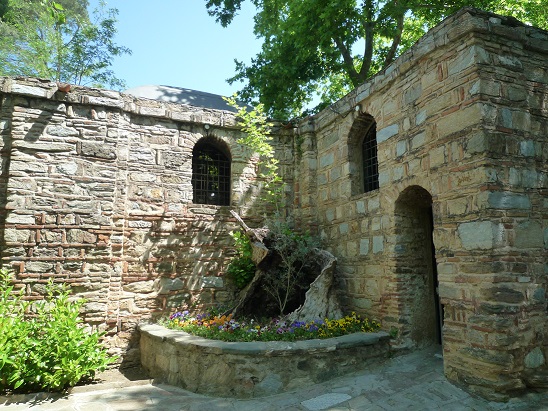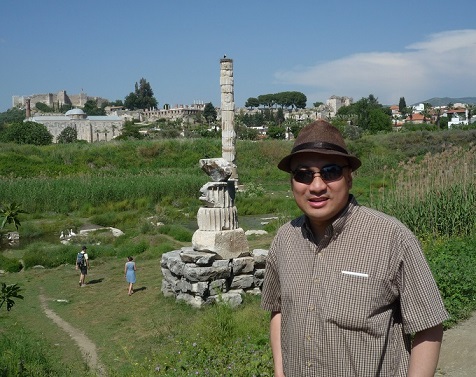A visit to the House of the Virgin Mary in Turkey

The House of the Virgin Mary in Ephesus, where the mother of Jesus, was believed to have traveled to, accompanied by St. John. Photos by Wendell Gaa
My father had always wanted to visit the historic city of Ephesus, which has been mentioned quite a few times in the New Testament of the Bible, having been one of the cities where Paul the Apostle was chronicled to have traveled to in spreading the early gospel of Christianity. We consulted with our longtime family friend and host Philippine Ambassador to Turkey Maria Rowena Sanchez, who recommended we travel to Ephesus by plane.
With some assistance by the embassy’s charming Turkish translator Duygu, we were able to book online a reasonably priced plane to transport us to Ephesus early in the morning the following day.
After nearly an hour’s trip, we landed at the city of Izmir along the western Turkish coastline, and observed how it was brightly sunny with a warm Mediterranean feel, unlike Ankara which was often damp and overcast during the days we spent there. Our local guide met us at the airport, and although he could barely speak a word of English, he proved very helpful in driving us around.
Our drive through the countryside south of Izmir lasted nearly an hour before we finally arrived at the ancient city site of Ephesus. I’ve read how this place is actually considered the jewel in the crown of Turkey’s archaeological attractions. Now until I came here, the most impressive Roman ruins I’ve seen outside of Italy were in Libya back when I visited there in the 1990s (during my father’s tenure there as ambassador when the country was relatively stable). But here in Ephesus, I could plainly see the remarkable Greco-Roman architectural legacy in Turkey.
This city was founded in the 13th century BC, and by the end of the first century BC it was an influential Greek Aegean port town with a population of over 300,000. From when the Roman Empire laid claim to the town and the entire surrounding region, it became the capital city of Roman-controlled Asia during the rule of Emperor Augustus Caesar. Amazingly during the declining years of the Roman Empire from the 4th century AD onwards, Ephesus was not sacked by pillaging invaders like so many other towns were, which explained the good condition of what we saw of the Ephesus of today, at least by old antiquity standards.
Walking along the long cobbled pathways and beneath the several columns and arches of Ephesus reminded me of our past trips to the Coliseum in Rome and the Acropolis in Athens, but one building that is unique here is the restored two-story library of Celcus. Having been constructed in 135 AD, the entrance façade to this library remains impressively intact, with its magnificent pillars and finely designed interior. There are also papyrus rolls that can be viewed inside the library’s reading room.
Another badge of honor which Ephesus can lay claim for is having once been the site of the Temple of Artemis, one of the Seven Wonders of the ancient world. Our guide led us to its location, where sadly all that is left of it is a single tall column surrounded by debris. One can only imagine based on this lone column, standing at an amazing 13 feet, how enormous the temple truly was and that it was the first monumental structure to be made entirely out of marble. The temple was said to have been constructed around 650 BC in honor of the Greek goddess Artemis. The king of Lydia financed the creation of the temple and marshy ground was chosen as the building site as a precaution against future natural disasters such as earthquakes.
Ironically, legend points out that it was man, not nature, that proved to be the temple’s undoing, when on July 21, 356 BC the very day Alexander the Great was born, a mentally unstable arsonist named Herostratus seeking to gain immortality set the temple ablaze. According to myth, the goddess Artemis was too focused on ensuring Alexander’s successful birth to rescue her burning temple. Despite reconstruction in the succeeding years, never again would the temple regain its former glory, left to the mercy of time and decay.
Other astounding archaeological sites which we saw here was a first-century stadium that years ago hosted horse and chariot races on its 712-feet track. Famous Roman gladiatorial matches were also held here in front of an audience capacity of 70,000. Just envision scenes which occurred here centuries ago which may have been similar to what was portrayed in the classic period film “Gladiator” starring Oscar winner Russell Crowe, if you happened to watch it, which is one of my favorite movies depicting the Roman Empire in its heyday.
We fittingly concluded our entire day’s trip to Ephesus by touring the nearby House of the Virgin Mary, located some 15 minutes by road from the ancient city site. Mary, mother of Jesus, is believed to have been accompanied here by St. John after the Crucifixion of Christ. The House itself was closed to visitors, but we paid homage to Mother Mary at the small shrine nearby. While simplistic in appearance even for a pilgrimage site, we nonetheless felt conciliated, including my father who brought home a plastic bottle from “Mary’s well,” located a few steps down the shrine.














